Thermomechanical Behavior of Textile Reinforced Cementitious Composites Subjected to Fire
Abstract
1. Introduction
2. Materials and Methods
2.1. Matrix
2.2. Textile Reinforcement
2.3. Specimens
- Thickness of the concrete cover
- Time/temperature of exposure to fire
- Material of fibers
- Moisture content
- Face 2 is the face that was exposed to the fire during the fire test (also referred to as “surface” for the fire test). It is also the face that was subjected to tension during the bending test.
- Effective depth refers to the level of the most stressed fibers (starting from face 1) during the bending test. Thus, it is also the level of fibers which were closer to the exposed to fire surface, which are the fibers that were exposed to the highest temperature.
- Fiber volume fraction (Vf) was calculated only in the longitudinal direction of the specimens, in the direction of the tensile stresses during the bending test.
2.4. Fire Tests Set-up
2.5. Mechanical Tests Set-up
3. Results and Discussion
3.1. Fire-Testing Results
- Fire test 1: Series A was tested for a duration of 30 min.
- Fire test 2: Series B, C, D and F were tested for a duration of 30 min.
- Fire test 3: Series E was tested for a duration of 15 min.
3.2. Results from Coating Burn-off Tests
- The equipment that was used was a small electrical furnace with the capacity to reach 1000 °C.
- Apart from the temperature, the time of exposure also plays a significant role. The heating rate in the middle of the specimens (closest measurement to the level of the effective depth, thus, the fibers that are of interest) was almost the same in both the 15-min and the 30-min fire tests, equal to 18–19 °C/min. Therefore, the heating time was decided each time according to the target temperature and a standard heating rate of 18 °C/min.
- The cooling down of the specimens, after reaching the maximum temperature, was performed with a rate of 1.5 °C/min until a temperature of 200 °C, which is also a good approach of the cooling down rate that was measured at the 15-min fire test.
- The initial mass of the coating was calculated based on the weight of the textiles before and after coating, as provided by the technical datasheets.
3.3. Results from TRC Heating and Compression Tests
3.4. Bending Tests Results
3.4.1. Results from 15-Minute Fire Tests
- The mass loss of the coating is in the order of 20% or lower (see Figure 7); therefore, since most of the coating is still in place, the bond between the textiles and the mortar will not be completely lost as in Series A, B, C, D and F.
- Even though it is well-known that glass fibers lose their strength after being exposed to temperatures higher than 300 °C, it is also well known that carbon fibers maintain their capacity to even higher temperatures if they are not in oxidizing atmosphere [31]. Therefore, even though the glass fibers within the specimens of Series E do not provide significant load bearing capacity, the carbon fibers do.
- The matrix was exposed to a maximum temperature of 477 °C at the surface (face 2), while at the bottom side (face 1, which is subjected in compression at the flexural test, thus, it is the most contributing part of the mortar) the maximum temperature reached 317 °C. According to Table 4, the degradation of the mortar is also not critical. The loss of compressive strength is close to 20% (interpolation between 5% and 36%), while the reduction of the elastic modulus is close to 48% (interpolation between 23% and 72%).
3.4.2. Results from 30-Minute Fire Tests
- The temperature stability of the coating of the textiles seems to be the most decisive parameter regarding the residual strength of the TRC specimens, since it directly affects the bond between the matrix and the reinforcement. Thus, extra care must be given when thermoplastic coatings are used in applications with fire safety requirements.
- The increased concrete cover could potentially protect the reinforcement better than a thinner cover; however, it is suggested that the same cover be applied symmetrically, so that a high geometrical eccentricity is avoided.
4. Conclusions
- The most critical parameter that defines the residual strength of the TRC specimens after heating is the coating of the textiles. After the 15-min long fire test, where the temperature at the effective depth did not exceed 400 °C, the degradation was less severe, since the coating was not completely lost (less than 30%). The specimens in this case contained hybrid reinforcement of glass and carbon textiles and they suffered reductions of 74% and 48% in the initial and the post-cracking stiffness, respectively. The maximum force also dropped by 25%, while the corresponding maximum displacement increased by 68%.
- The textiles that were coated with a thermoplastic material retained a practically negligible residual strength after being subjected to a 30-min fire test, where the temperature at the level of the effective depth (most stressed fibers during the bending test) exceeded 500 °C. This corresponds to a mass loss of 90% or higher and is explained by the fact that the loss of the coating, which is an intermediate layer between the fibers and the matrix, leads to failure of the bond between the fibers and the matrix. The same result was observed regardless of the fiber material (glass or carbon), the thickness of the concrete cover (8 mm or 12 mm) and the moisture saturation of the specimens (0% or 50%).
- The degradation of the mortar due to the high temperature was also significant and could be another dominant parameter. Regarding the compressive strength and the elastic modulus, it was observed that the latter dropped faster with respect to the temperature of exposure. However, in both cases the degradation was not severe until 200 °C (5% and 23%, respectively), while it became critical at 500 °C (63% and 82% loss, respectively).
- The temperature profile within the cross section of the one-sided exposed specimens of TRC was not uniform. Specifically, the temperature reduction through the top part of the specimens appeared to be higher due to the lower thermal conductivity of the top, hotter, layers. Thus, the concrete cover is also a potential critical parameter that could determine the residual strength of the heated specimens. The effect of the concrete cover, though, was not quantified in this study.
- Finally, it was concluded that a highly asymmetrical design scheme can be disastrous for the case of one-sided exposure to fire, since the double asymmetry (in heating and in axial stiffness) can lead to premature failure of the specimens solely due to thermal stresses.
Author Contributions
Funding
Acknowledgments
Conflicts of Interest
References
- Hothan, S.; Ehlig, D. Reinforced concrete slabs strengthened with textile reinforced concrete subjected to fire. In Proceedings of the 2nd International RILEM Work Concrete Spalling Due to Fire Exposure, Delft, The Netherlands, 5–7 October 2011; RILEM Publications: Bagneux, France, 2011; pp. 419–426. [Google Scholar]
- Hashemi, S.; Al-Mahaidi, R. Experimental and finite element analysis of flexural behavior of FRP-strengthened RC beams using cement-based adhesives. Constr. Build. Mater. 2012, 26, 268–273. [Google Scholar] [CrossRef]
- Bisby, L. Design for fire of concrete elements strengthened or reinforced with fibre-reinforced polymer: State of the art and opportunities from performance-based approaches. Can. J. Civ. Eng. 2013, 40, 1034–1043. [Google Scholar] [CrossRef]
- Michels, J.; Zwicky, D.; Scherer, J.; Harmanci, Y.E. Structural strengthening of concrete with fiber reinforced cementitious matrix (FRCM) at ambient and elevated temperature—Recent investigations in Switzerland. Adv. Struct. Eng. 2014, 17. [Google Scholar] [CrossRef]
- Tetta, Z.C.; Bournas, D.A. TRM vs FRP jacketing in shear strengthening of concrete members subjected to high temperatures. Compos. Part B 2016, 106, 190–205. [Google Scholar] [CrossRef]
- Raoof, S.M.; Bournas, D.A. TRM versus FRP in flexural strengthening of RC beams: Behaviour at high temperatures. Constr. Build. Mater. 2017, 154, 424–437. [Google Scholar] [CrossRef]
- Raoof, S.M.; Bournas, D.A. Bond between TRM versus FRP composites and concrete at high temperatures. Compos. Part B Eng. 2017, 127, 150–165. [Google Scholar] [CrossRef]
- Ombres, L. Analysis of the bond between Fabric Reinforced Cementitious Mortar (FRCM) strengthening systems and concrete. Compos. Part B Eng. 2015, 69, 418–426. [Google Scholar] [CrossRef]
- Triantafillou, T.; Karlos, K.; Kefalou, K.; Argyropoulou, E. An innovative structural and energy retrofitting system for masonry walls using textile reinforced mortars combined with thermal insulation. RILEM Bookser. 2018, 15, 752–761. [Google Scholar]
- Maroudas, S.R.; Papanicolaou, C.G. Effect of High Temperatures on the TRM-to-Masonry Bond. Key Eng. Mater. 2017, 747, 533–541. [Google Scholar] [CrossRef]
- Ombres, L.; Iorfida, A.; Mazzuca, S.; Verre, S. Bond analysis of thermally conditioned FRCM-masonry joints. Measurement 2018, 125, 509–515. [Google Scholar] [CrossRef]
- Ehlig, D.; Jesse, F.; Curbach, M. High temperature tests on textile reinforced concrete (TRC) strain specimens. In Proceedings of the International RILEM Conference on Material Science (MatSci), Aachen, Germany, 6–8 September 2010. [Google Scholar]
- Hegger, J.; Horstmann, M.; Zell, M. Applications for TRC. In Proceedings of the 15th International Congress of the GRCA, Prague, Czech Republic, 20–23 April 2008. [Google Scholar]
- Rambo, D.A.; Silva, F.D.A.; Filho, R.D.T.; Ukrainczyk, N.; Koenders, E. Tensile strength of a calcium-aluminate cementitious composite reinforced with basalt textile in a high-temperature environment. Cem. Concr. Compos. 2016, 70, 183–193. [Google Scholar] [CrossRef]
- Silva, F.D.A.; Butler, M.; Hempel, S.; Filho, R.D.T.; Mechtcherine, V. Effects of elevated temperatures on the interface properties of carbon textile-reinforced concrete. Cem. Concr. Compos. 2014, 48, 26–34. [Google Scholar] [CrossRef]
- Xu, S.; Shen, L.; Wang, J. The high-temperature resistance performance of TRC thin-plates with different cementitious materials: Experimental study. Constr. Build. Mater. 2016, 115, 506–519. [Google Scholar] [CrossRef]
- Ward, M.; Bisby, L.; Stratford, T.; Roy, E. Fibre Reinforced Cementitious Matrix systems for fire-safe flexural strengthening of concrete: Pilot testing at ambient temperatures. In Proceedings of the 4th International Conference on Advanced Composites in Construction, Chesterfield, UK, 3–5 September 2009; NetComposites Ltd.: Chesterfield, UK, 2009; pp. 449–460. [Google Scholar]
- Donnini, J.; Basalo, F.D.C.; Corinaldesi, V.; Lancioni, G.; Nanni, A. Fabric-reinforced cementitious matrix behavior at high-temperature: Experimental and numerical results. Compos. Part B Eng. 2017, 108, 108–121. [Google Scholar] [CrossRef]
- Çavdar, A. A study on the effects of high temperature on mechanical properties of fiber reinforced cementitious composites. Compos. Part B Eng. 2012, 43, 2452–2463. [Google Scholar] [CrossRef]
- Caverzan, A.; Colombo, M.; di Prisco, M.; Rivolta, B. High performance steel fibre reinforced concrete: Residual behaviour at high temperature. Mater. Struct. 2015, 48, 3317–3329. [Google Scholar] [CrossRef]
- Colombo, I.; Colombo, M.; Magri, A.; Zani, G.; Di Prisco, M. Textile reinforced mortar at high temperatures. Appl. Mech. Mater. 2011, 82, 202–207. [Google Scholar] [CrossRef]
- Rambo, D.A.S.; Silva, F.D.A.; Filho, R.D.T.; Da Gomes, O.F.M. Effect of elevated temperatures on the mechanical behavior of basalt textile reinforced refractory concrete. Mater. Des. 2015, 65, 24–33. [Google Scholar] [CrossRef]
- Rambo, D.A.S.; Yao, Y.; Silva, F.D.A.; Filho, R.D.T.; Mobasher, B. Experimental investigation and modelling of the temperature effects on the tensile behavior of textile reinforced refractory concretes. Cem. Concr. Compos. 2017, 75, 51–61. [Google Scholar] [CrossRef]
- Nguyen, T.H.; Vu, X.H.; Si Larbi, A.; Ferrier, E. Experimental study of the effect of simultaneous mechanical and high-temperature loadings on the behaviour of textile-reinforced concrete (TRC). Constr. Build. Mater. 2016, 125, 253–270. [Google Scholar] [CrossRef]
- Keleştemur, O.; Arıcı, E.; Yıldız, S.; Gökçer, B. Performance evaluation of cement mortars containing marble dust and glass fiber exposed to high temperature by using Taguchi method. Constr. Build. Mater. 2014, 60, 17–24. [Google Scholar] [CrossRef]
- Reinhardt, H.W.; Kruger, M.; Raupach, M. Behavior of textile-reinforced concrete in fire. ACI Spec. Publ. 2008, SP250, 99–100. [Google Scholar]
- Antons, U.; Hegger, J.; Kulas, C.; Raupach, M. High-temperature tests on concrete specimens reinforced with alkali-resistant glass rovings under bending loads. In Proceedings of the 6th International Conference on FRP Composites in Civil Engineering, Rome, Italy, 13–15 June 2012. [Google Scholar]
- Buttner, R.M.; Orlowsky, J.; Raupach, M. Fire Resistance Tests of Textile Reinforced Concrete under Static Loading—Results and Future Developments, Proceedings of the 5th International RILEM Workshop on High Performance Fiber Reinforced Cement Composites, Mainz, Germany, 10–13 July 2007; Reinhardt, H.W., Naaman, A.E., Eds.; RILEM Publications: Bagneux, France, 2014. [Google Scholar]
- BS EN 1363-1:1991. Fire Resistance Tests—Part 1: General Requirements; British Standards Institution (BSI): London, UK, August 1991. [Google Scholar]
- Brameshuber, W. (RILEM Technical Committee). Recommendation of RILEM TC 232-TDT: test methodsand design of textile reinforced concrete. Uniaxial tensile test: test method to determine the load bearing behavior of tensile specimens made of textile reinforced concrete. Mater. Struct. 2016, 49, 4923–4927. [Google Scholar]
- Triantafillou, T. Textile Fibre Composites in Civil Engineering; Woodhead Publishing: London, UK, 2016; pp. 173–174. [Google Scholar]

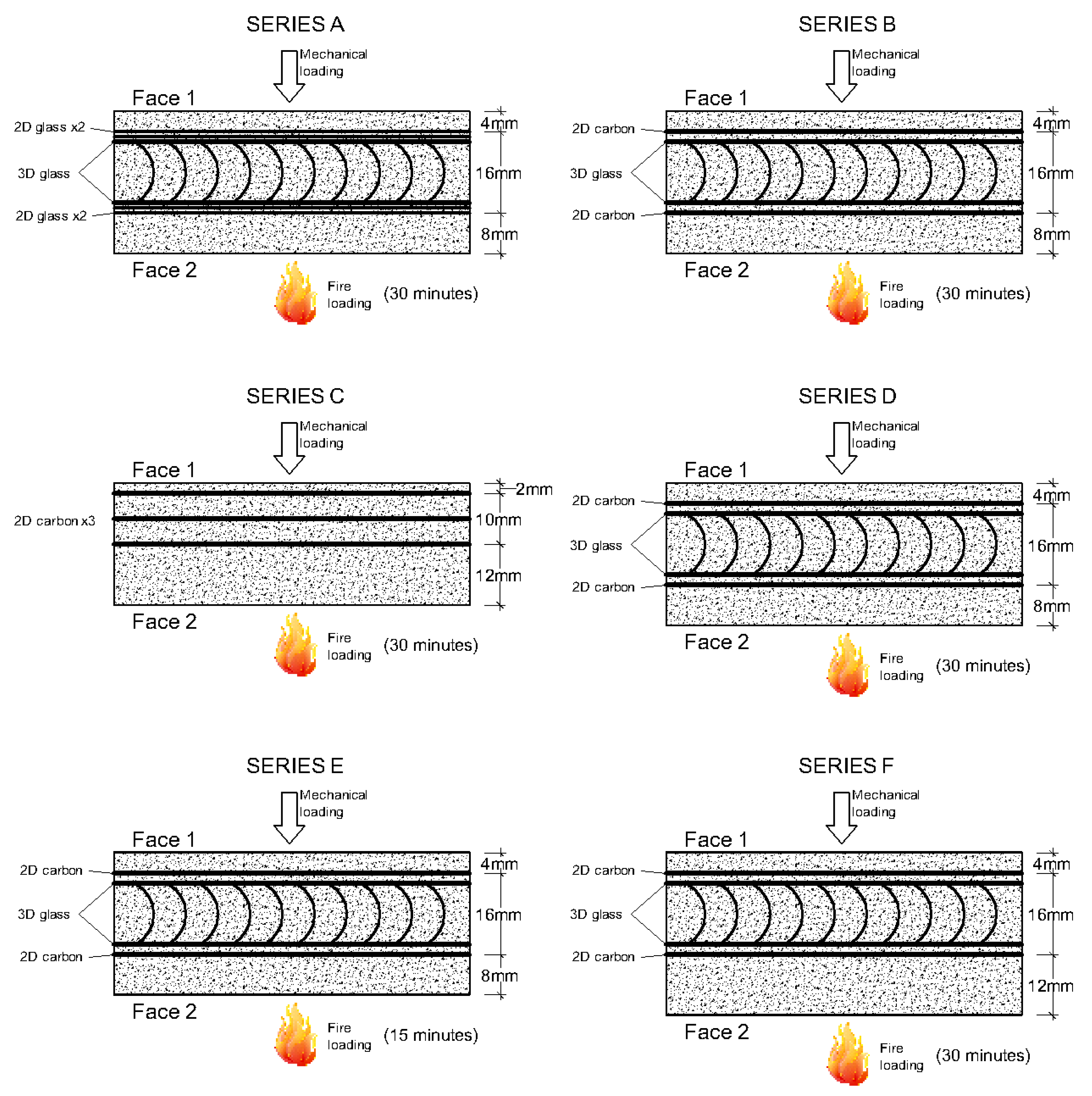
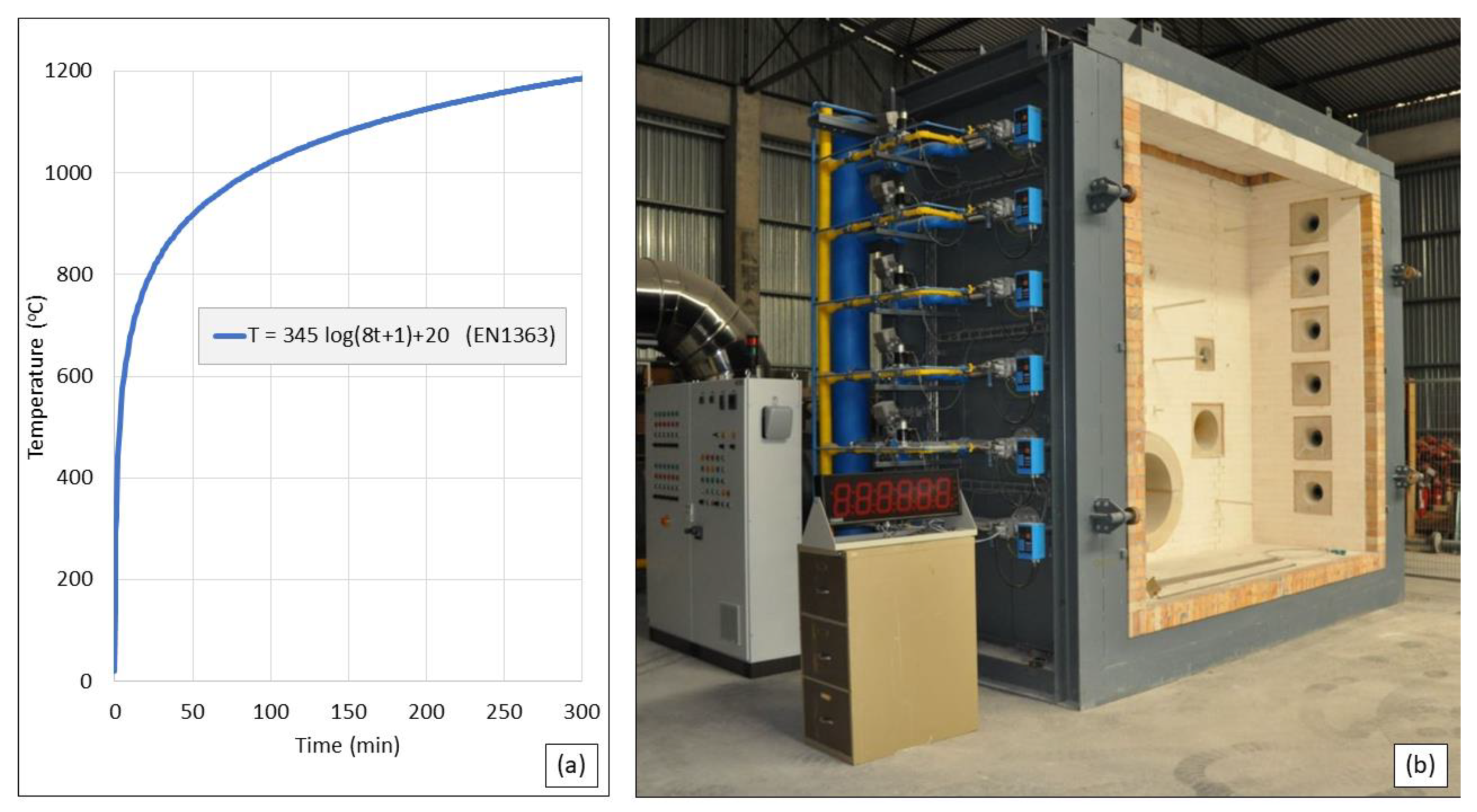

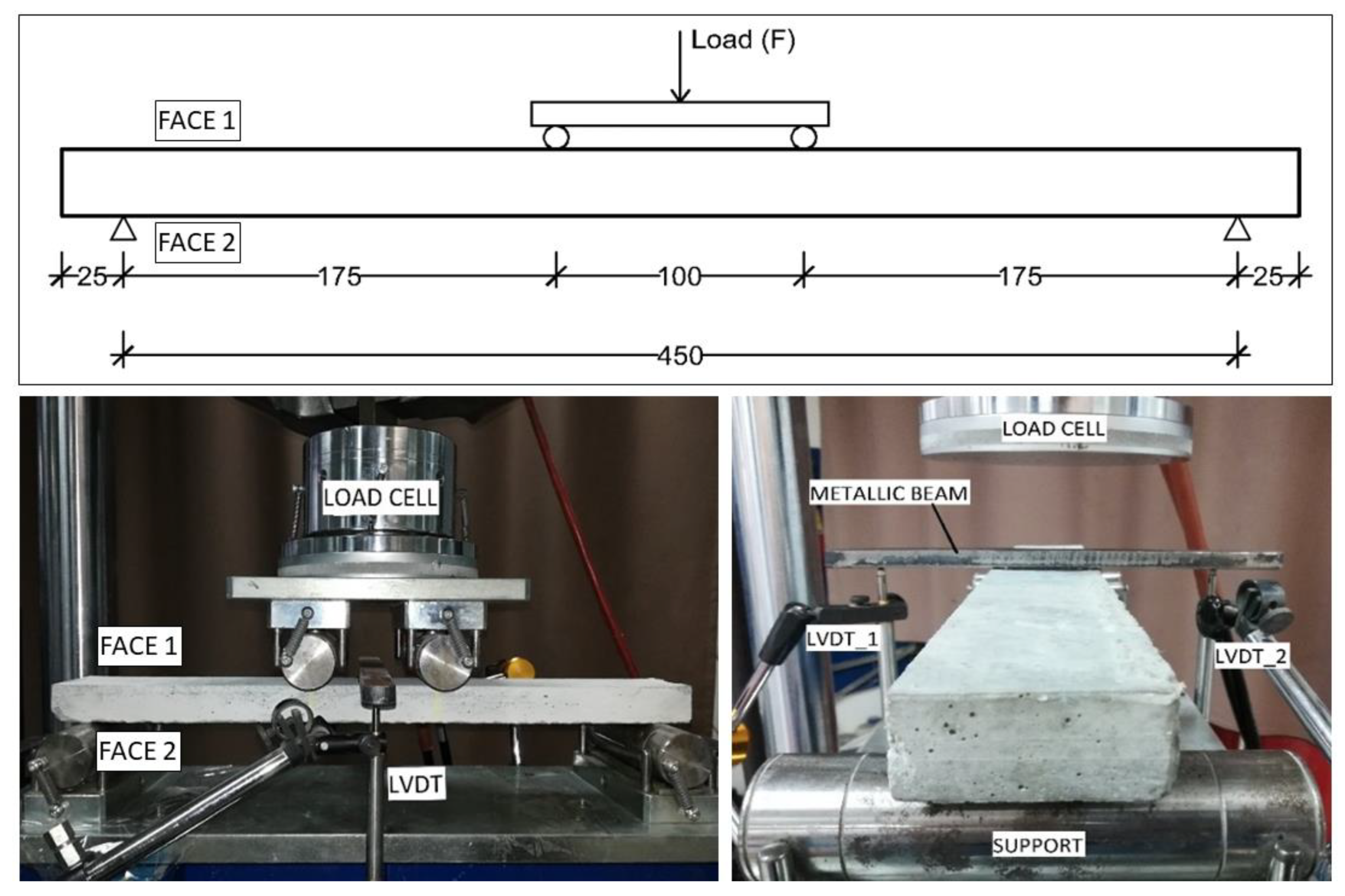
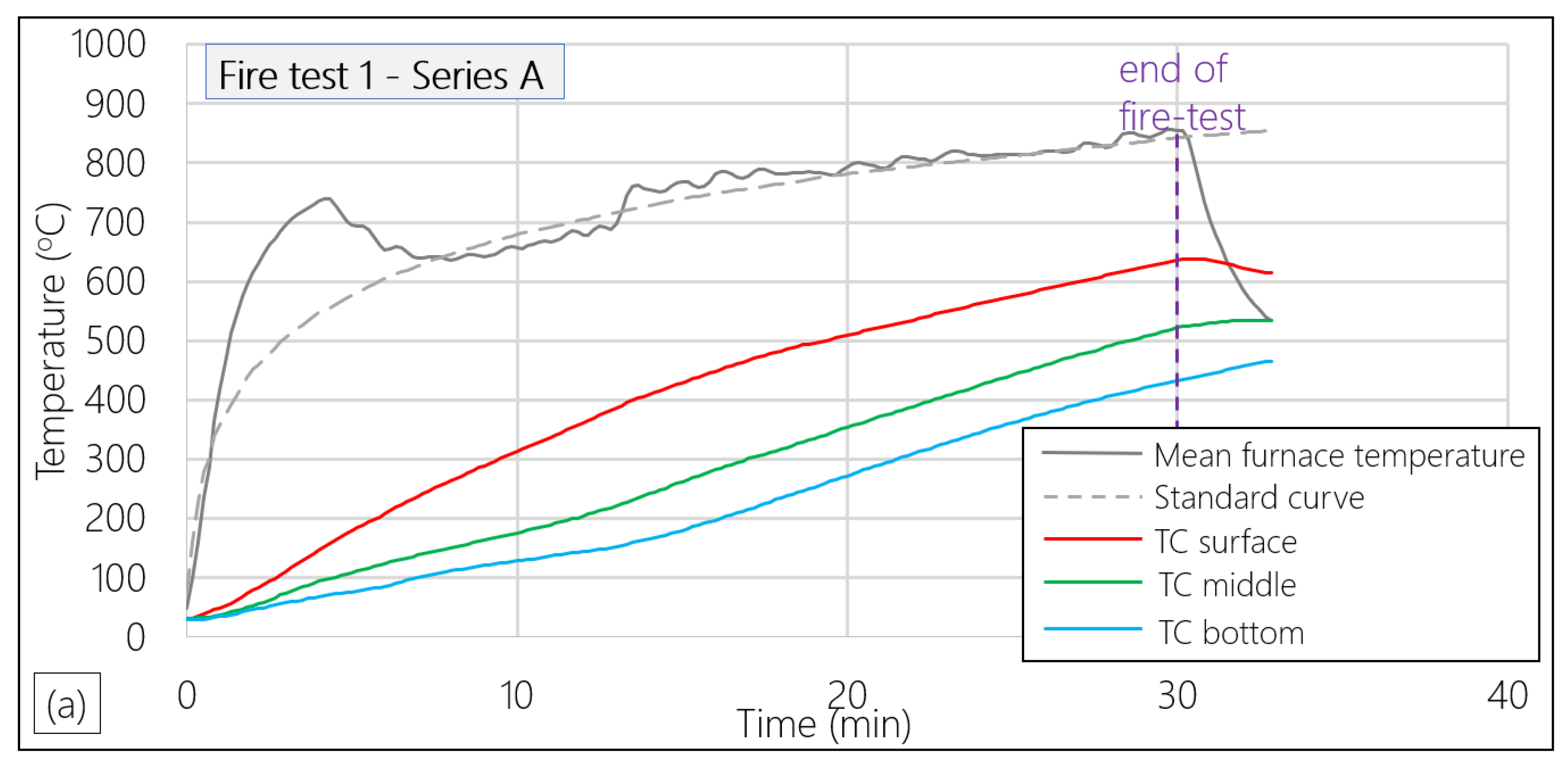
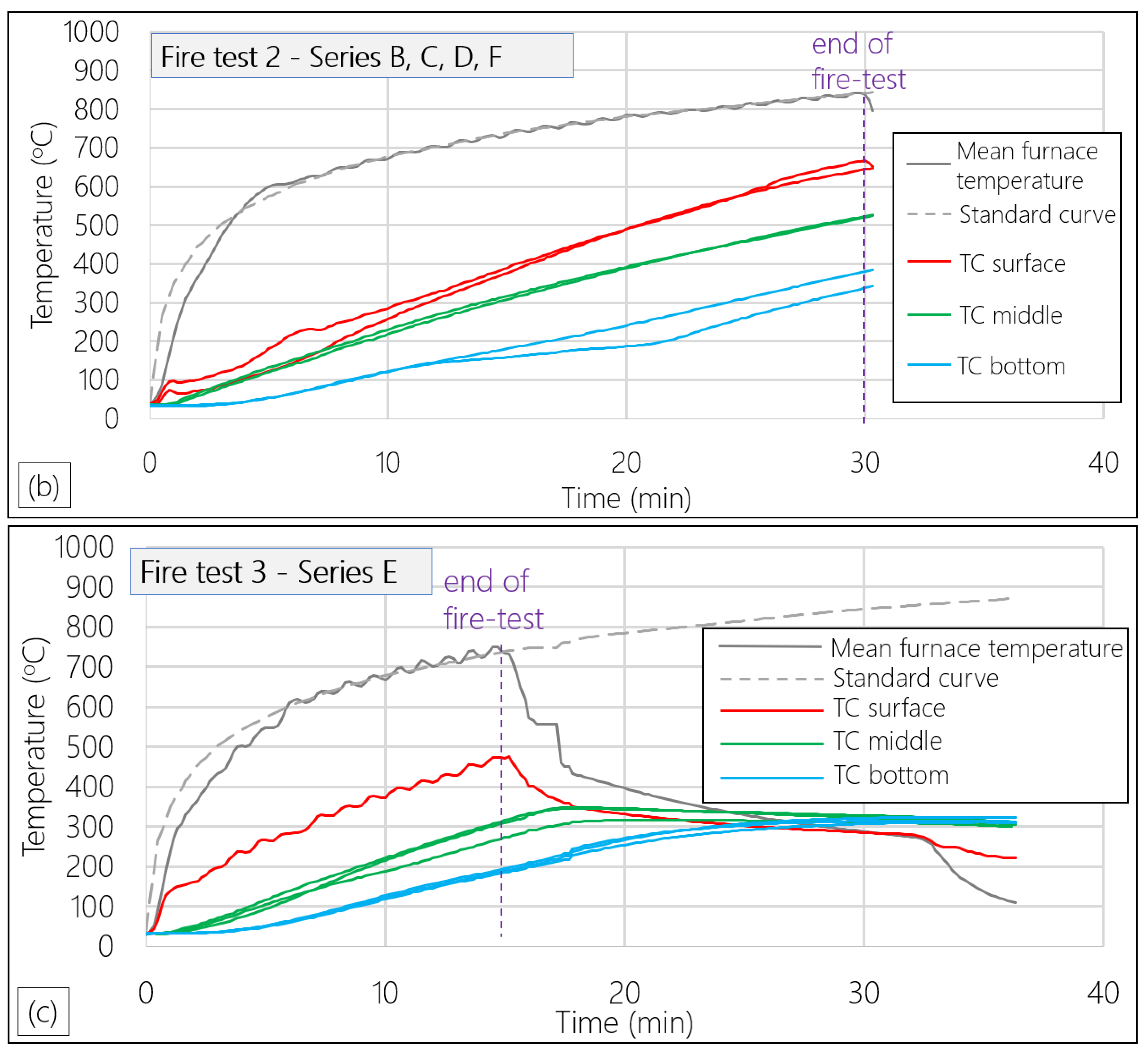
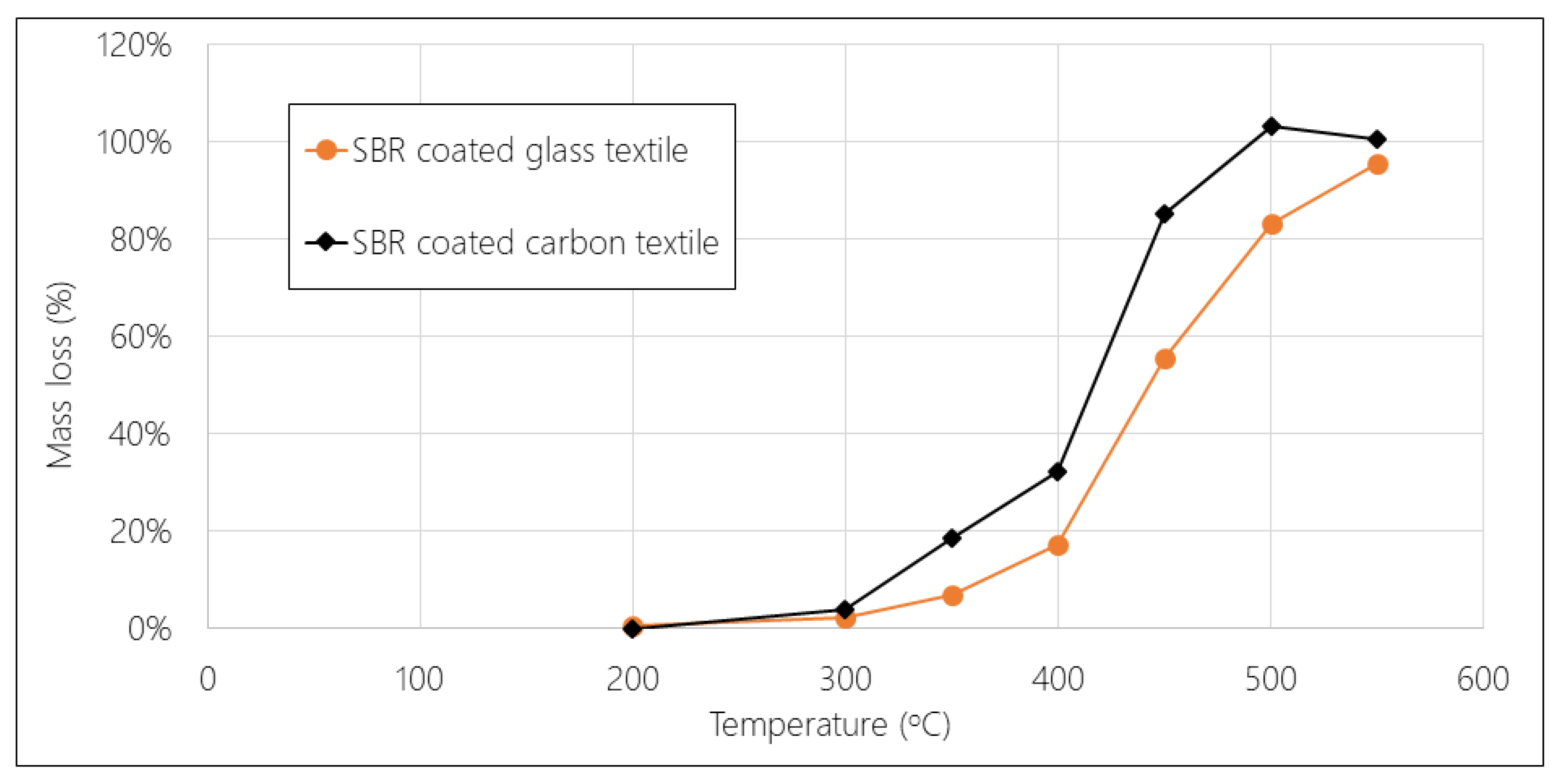

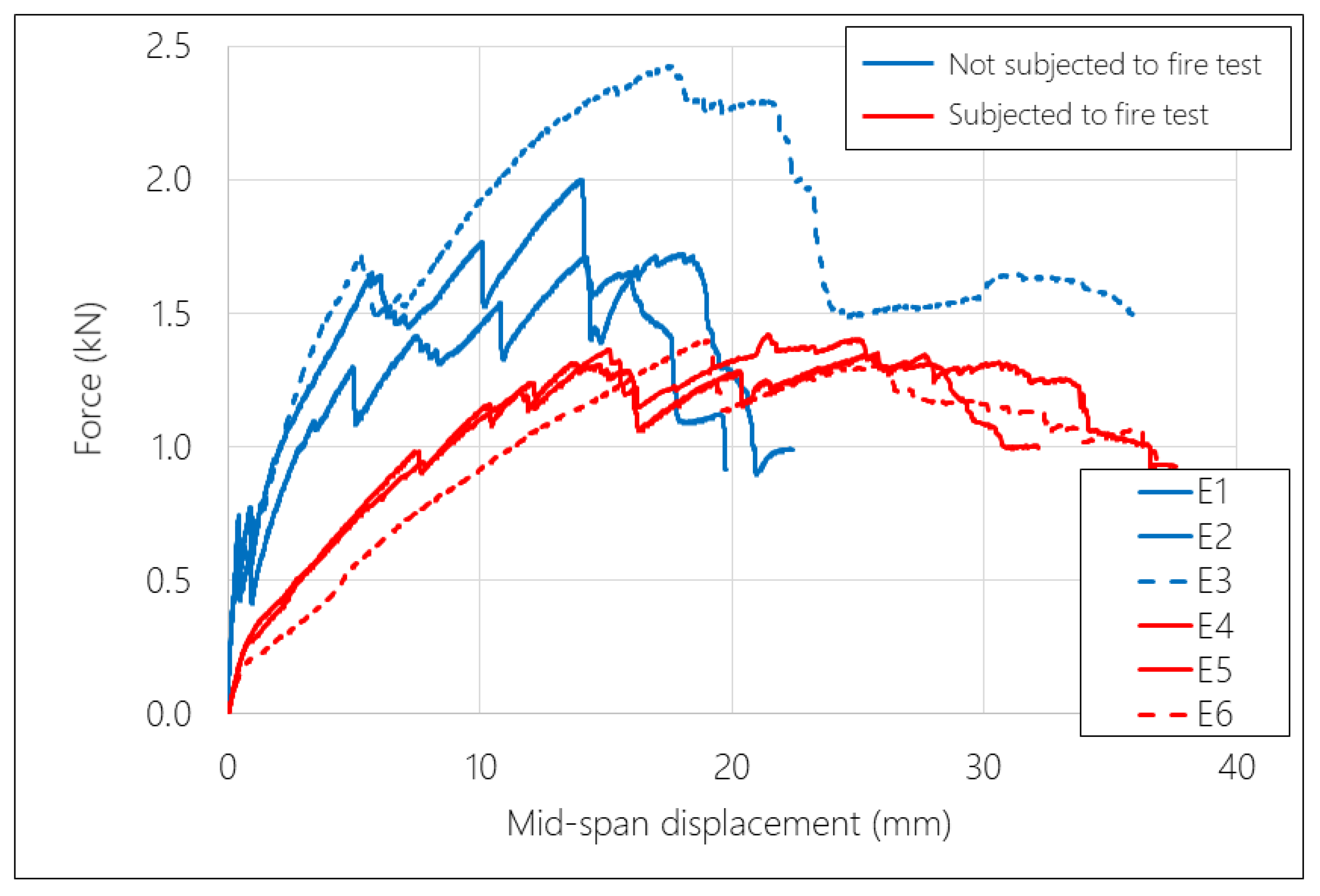
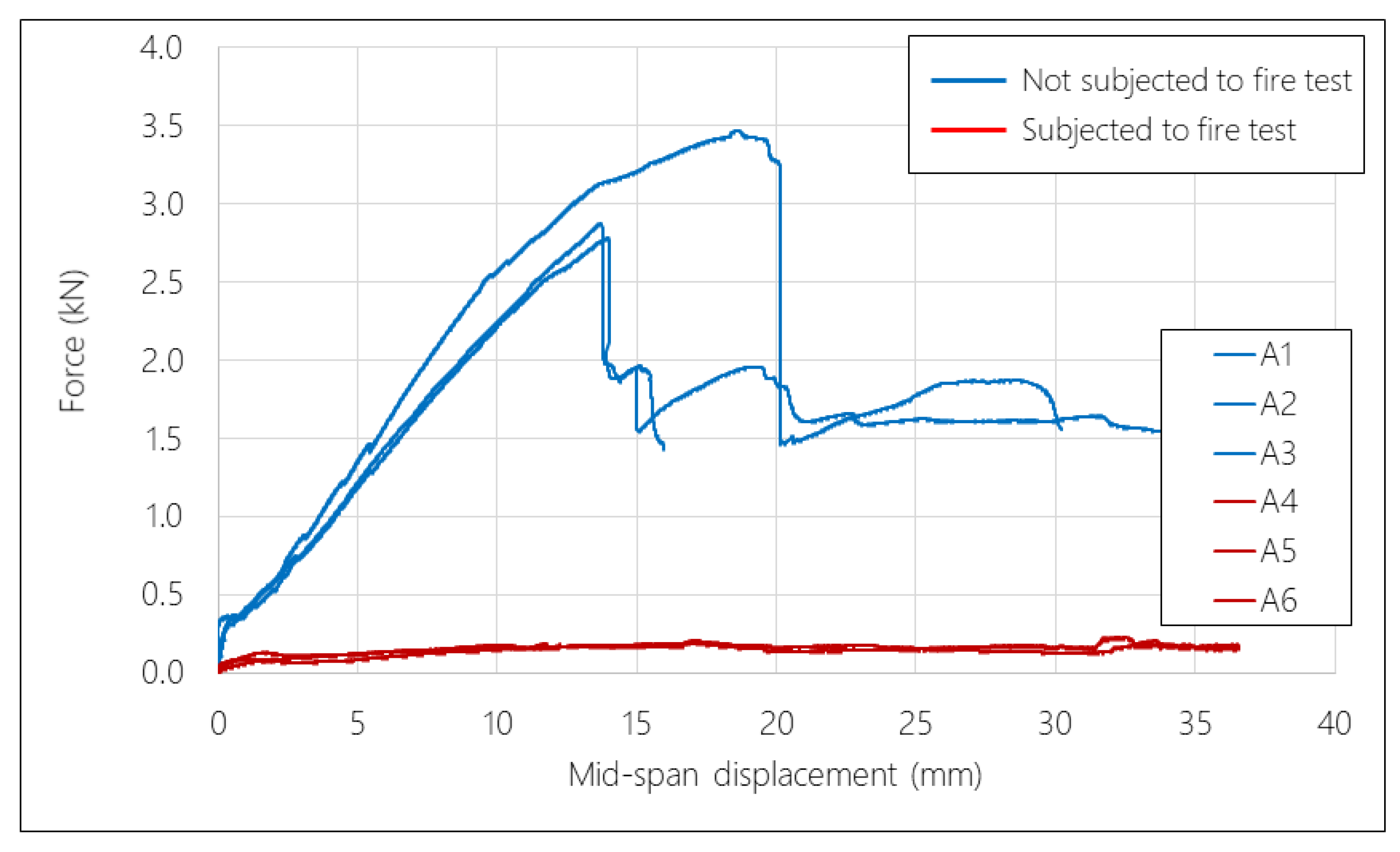

| Type of Textile | Roving Distance (mm) | Weight before Finishing (gr/m2) | Nominal Thickness (mm) | Yarn Failure Stress (MPa) | Yarn Stiffness (GPa) | ||||
|---|---|---|---|---|---|---|---|---|---|
| warp | weft | warp | weft | warp | weft | ||||
| Two-dimensional (2D) glass | 12 | 12 | 284 | 284 | 0.106 | 0.106 | 526 | 67 | |
| Three-dimensional (3D) glass styrene-butadiene (SBR) coated | Face 1 | 10 | 10 | 229.3 | 229.3 | 0.171 | 0.171 | 496 | 67 |
| Face 2 | 18 | 9 | 229.3 | 229.3 | 0.171 | 0.171 | |||
| 2D carbon SBR coated | 12.7 | 12.7 | 258 | 258 | 0.143 | 0.143 | 814 | 93 | |
| Fire Test | Series | Type of Reinforcement | Cover Thickness (mm) | Total Thickness (mm) | Effective Depth (mm) | Time of Exposure (min) | Moisture Saturation (%) | Fiber Volume Fraction (%) | |
|---|---|---|---|---|---|---|---|---|---|
| Face 1 | Face 2 | ||||||||
| TEST 1 | A | Glass | 4 | 8 | 28 | 20 | 30 | 0 | 2.17 |
| TEST 2 | B | Glass + carbon | 4 | 8 | 28 | 20 | 30 | 0 | 1.47 |
| C | Carbon | 2 | 12 | 24 | 12 | 30 | 0 | 1.82 | |
| D | Glass + carbon | 4 | 8 | 28 | 20 | 30 | 50 | 1.47 | |
| F | Glass + carbon | 4 | 12 | 32 | 20 | 30 | 0 | 1.29 | |
| TEST 3 | E | Glass + carbon | 4 | 8 | 28 | 20 | 15 | 0 | 1.47 |
| Fire Test | Duration (min.) | Series | Temperature at the End of the Fire Test (°C) | ||
|---|---|---|---|---|---|
| surface | middle | bottom | |||
| 1 | 30 | A | 638 | 525 | 437 |
| 2 | 30 | B | 648 | 526 | 343 |
| C | - | - | - | ||
| D | 650 | 530 | 343 | ||
| F | 666 | 524 | 385 | ||
| 3 | 15 | E | 477 | 302 | 192 |
| Temperature (°C) | Reduction of Compressive Strength | Reduction of Elastic Modulus |
|---|---|---|
| 20 | - | - |
| 200 | 5% | 23% |
| 400 | 36% | 72% |
| 500 | 63% | 82% |
| 700 | 71% | 85% |
| Mechanical Properties | Not Exposed Specimens (E1, E2) | Exposed Specimens (E4, E5) | Difference (%) |
|---|---|---|---|
| k1 (kN/m) | 1.58 | 0.41 | −74% |
| k2 (kN/m) | 0.20 | 0.10 | −48% |
| Fmax (kN) | 1.86 | 1.39 | −25% |
| δmax (mm) | 14.1 | 23.6 | +68% |
© 2019 by the authors. Licensee MDPI, Basel, Switzerland. This article is an open access article distributed under the terms and conditions of the Creative Commons Attribution (CC BY) license (http://creativecommons.org/licenses/by/4.0/).
Share and Cite
Kapsalis, P.; El Kadi, M.; Vervloet, J.; De Munck, M.; Wastiels, J.; Triantafillou, T.; Tysmans, T. Thermomechanical Behavior of Textile Reinforced Cementitious Composites Subjected to Fire. Appl. Sci. 2019, 9, 747. https://doi.org/10.3390/app9040747
Kapsalis P, El Kadi M, Vervloet J, De Munck M, Wastiels J, Triantafillou T, Tysmans T. Thermomechanical Behavior of Textile Reinforced Cementitious Composites Subjected to Fire. Applied Sciences. 2019; 9(4):747. https://doi.org/10.3390/app9040747
Chicago/Turabian StyleKapsalis, Panagiotis, Michael El Kadi, Jolien Vervloet, Matthias De Munck, Jan Wastiels, Thanasis Triantafillou, and Tine Tysmans. 2019. "Thermomechanical Behavior of Textile Reinforced Cementitious Composites Subjected to Fire" Applied Sciences 9, no. 4: 747. https://doi.org/10.3390/app9040747
APA StyleKapsalis, P., El Kadi, M., Vervloet, J., De Munck, M., Wastiels, J., Triantafillou, T., & Tysmans, T. (2019). Thermomechanical Behavior of Textile Reinforced Cementitious Composites Subjected to Fire. Applied Sciences, 9(4), 747. https://doi.org/10.3390/app9040747






